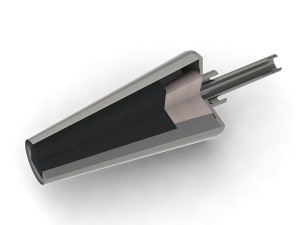- 18
- Sep
Analysis of the characteristics of the use of diffuse ventilating bricks
Analysis of the characteristics of the use of diffuse ventilating bricks
The new type of diffuse ventilating bricks will not produce the bottom blowing impermeability or undesirable phenomenon of the original slit ventilating bricks due to its microstructure characteristics. When the slit ventilating brick is working and ventilating, the cold air moves in the slit to produce a larger temperature gradient, and some of the thermal stress generated will be concentrated near the slit, especially the thermal stress at the air outlet of the slit is greater, making the slit in The scale changes during use, which causes the molten steel to easily penetrate into the slit to form a bottom-blowing impermeability or undesirable phenomenon. In addition, if the bottom blowing valve is quickly closed at the end of the essence, the molten steel will enter the slit at a positive pressure, so it is necessary to install a reverse impregnation check valve on the argon blowing pipeline.
Therefore, slit-type air-permeable bricks must have suitable and stable slit air passage dimensions and materials with good thermal stability in order to reduce slit steel. The air permeable channel of the diffuse ventilating brick is a large number of connected visible pores dispersed in the brick body (as shown in Figure 2). These micron-scale tortuous channels constitute a relatively large resistance to the penetration of molten steel, and they are basically non-penetrating in actual use. , The air bubbles generated by the dispersive air-permeable brick are small, uniform and dense, it is easier to stir the molten steel to a uniform temperature, and it is easier to promote the floating of the inclusions to achieve a better essence.
The new diffused air-permeable brick is not easy to cause cross-section of the brick core surface. When blowing argon, the air outlet of the slit type air-permeable brick is directly touched with the high temperature molten steel and the cold air flow continuously flows out, resulting in a large temperature gradient. The thermal stress at the air outlet forming the slit is particularly large. During the process, the rapid heat and cold will cause cross-cutting near the air outlet of the slit, which will cause the slit to shift and make the bottom blowing impermeable. The thermal stress caused by the temperature-falling volume shrinkage and the volumetric expansion of other parts can easily form the slit-type air-permeable brick to produce cross-section, which puts forward higher requirements for the thermal shock resistance of the refractory material. However, there are micron gas channels on the entire working surface of the diffuse ventilating brick, and the temperature gradient of the working surface is small, so that the new diffuse ventilating brick is not easy to produce cross-section of the brick core surface.

